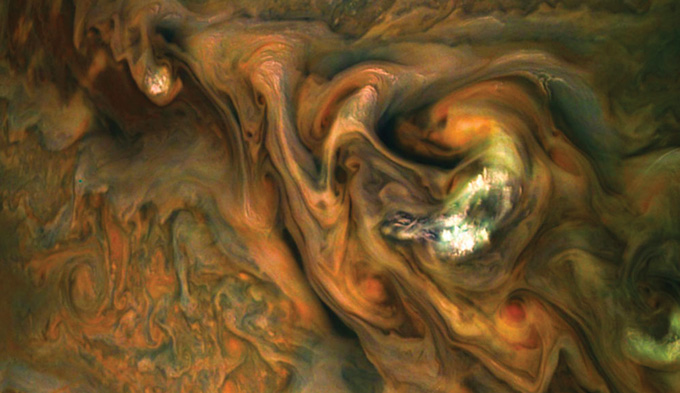
Visitors to the village of Drumnadrochit, on the western shore of Scotland’s murky Loch Ness, come to see the nearby ruins of Urquhart Castle or to chance a glimpse of the elusive Loch Ness Monster. But growing up in Drumnadrochit, planetary scientist Robin Wordsworth says it was the unobscured view of the cosmos that seized his attention. “There are incredibly clear skies up there,” he says.
Today, Wordsworth lives on the other side of the Atlantic. He’s a researcher and professor at Harvard University. But his gaze is still set on the solar system and beyond. From studying how rocky planets may occasionally become encased in glaciers to exploring the sizes of alien raindrops or the details of how humans might one day settle Mars, Wordsworth’s scientific explorations vary widely. His research group tends to “do a lot of different things at once,” he says. “If I was to summarize it in a sentence, it would be to understand what drives habitability on planets through time.”
Standout research
Wordsworth defines a planet’s habitability as its ability to support life. The idea that life could survive elsewhere in the cosmos has always fascinated Wordsworth, a science fiction fan. Apart from Earth, astronomers have discovered roughly 20 potentially habitable worlds in the universe. With data collected by ground-based observatories, satellites and rovers, he uses supercomputers to construct simulations of planets and the evolution of their climates. Climate is a big focus because it determines whether a planet’s surface can harbor liquid water — a necessity for all known forms of life.
 The swirling clouds of Jupiter, captured by NASA’s Juno spacecraft, could release semisolid ammonia slushballs of precipitation. Work by Robin Wordsworth and a colleague suggests that the size of such alien raindrops is similar no matter what they’re made of or what planet they fall on.GERALD EICHSTADT/MSSS/SWRI, JPL-CALTECH/NASA
The swirling clouds of Jupiter, captured by NASA’s Juno spacecraft, could release semisolid ammonia slushballs of precipitation. Work by Robin Wordsworth and a colleague suggests that the size of such alien raindrops is similar no matter what they’re made of or what planet they fall on.GERALD EICHSTADT/MSSS/SWRI, JPL-CALTECH/NASA
Wordsworth’s most notable research reconstructs the climate of early Mars. Martian river valleys and other geologic clues suggest that abundant liquid water once flowed across the Red Planet, and the early Martian climate has thus become a hot topic for scientists seeking signs of alien life. But for decades, the best researchers could do was build one-dimensional models that struggled to replicate key atmospheric components, such as clouds.
In 2013 while at the Laboratory of Dynamic Meteorology in Paris, Wordsworth and colleagues presented a 3-D model of the early Martian climate, with clouds and an atmosphere containing large amounts of carbon dioxide. Those are key components for studying how the early Martian atmosphere may have reflected and trapped heat, says astrobiologist James Kasting of Penn State.
Wordsworth was the one who figured out how to incorporate clouds into the model, thanks to his strong programming skills, handle over mathematics and determination, Kasting says. “He’s been publishing the best climate calculations for early Mars. There’s really nobody else who is in his lane.”

Sign Up For the Latest from Science News
Headlines and summaries of the latest Science News articles, delivered to your inbox
Client key* E-mail Address* Go
Thank you for signing up!
There was a problem signing you up.
What’s next
Wordsworth’s otherworldly reconstructions may help us better understand whether life might have emerged on Mars or elsewhere. Another strand of his research could help humans one day settle the Red Planet.
Today, most of Mars’ surface is too cold to sustain liquid water, and the planet’s thin atmosphere offers little protection from the sun’s intense ultraviolet radiation. These conditions make it inhospitable to would-be Martian settlers. But in a 2019 study, Wordsworth and colleagues proposed that sheets of insulating silica aerogel deployed over ice-covered areas might make survival possible.
In lab tests, layers of aerogel just centimeters thick filtered out 60 percent of UVA and UVB radiation and almost all of the more dangerous UVC rays, while permitting enough light through for photosynthesis. What’s more, the shields warmed the air underneath by more than 50 degrees Celsius, which could make liquid water and growing crops possible. Looking ahead, Wordsworth plans to investigate how settlers on Mars might use bioplastics or other renewable materials to become self-sustaining.
And far beyond the Red Planet, the exoplanets await. “The James Webb Space Telescope has just begun to collect new exoplanet data,” Wordsworth says. Observations of their atmospheres will help researchers test ideas about how these distant planets and their climates evolve, he says. “It’s just an incredibly exciting time.”
Want to nominate someone for the next SN 10 list? Send their name, affiliation and a few sentences about them and their work to [email protected].

